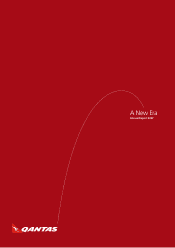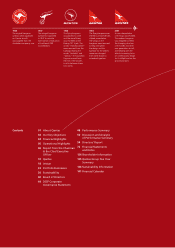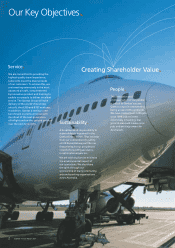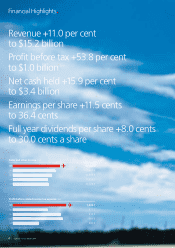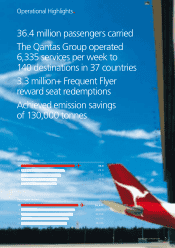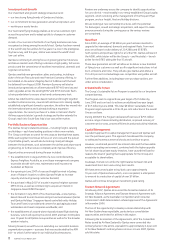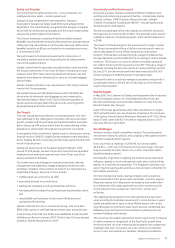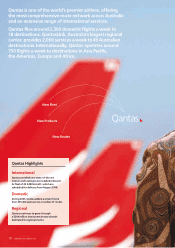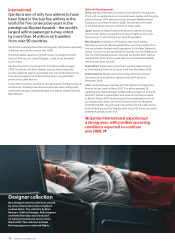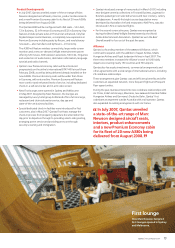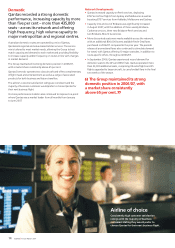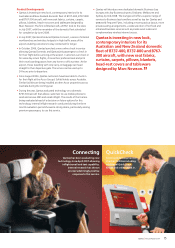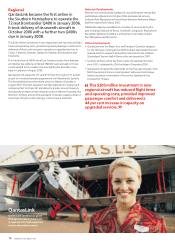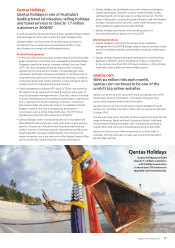Qantas 2007 Annual Report Download - page 9
Download and view the complete annual report
Please find page 9 of the 2007 Qantas annual report below. You can navigate through the pages in the report by either clicking on the pages listed below, or by using the keyword search tool below to find specific information within the annual report.
7Qantas |Annual Report 2007
Report from the Chairman & the Chief Executive Officer
To our fellow shareholders
During the difficult first six years of this century, the aviation industry
confronted the challenges of war, terrorism, fuel price rises, the SARS
virus and a massive industry downturn.
However, Qantas remained focused on long-term growth, developing
an innovative two brand strategy and investing billions of dollars in
fleet, product and customer service, while also working hard to attack
inefficiencies, change work practices and lower our cost base.
Today, we are in a new global operating environment for aviation.
Passenger numbers are up, productivity has increased, costs have been
reduced, and some industry consolidation is underway. The Asia
Pacific region, centred around China and India, is expected to become
the world’s single largest aviation market by 2010.
Next year, new generation aircraft, led by the Airbus A380 and the
Boeing 787 Dreamliner, will come online and offer passengers an
exciting new standard in flying.
The Qantas Group has worked hard to position itself to take advantage
of this very positive environment – and our results reflect the skill and
dedication of all our people.
Our Results
Qantas announced a record profit before tax of $1,032.1 million for
the year ended 30 June 2007, a 53.8 per cent increase on the prior
year, achieved in a strong operating environment.
At the same time, jet fuel prices remained high, increasing costs by
around $500 million before hedging benefits.
Highlights included:
• profit before tax of $1,032.1 million;
• net profit after tax of $719.6 million;
• revenue of $15.2 billion;
• earnings per share of 36.4 cents; and
• operating cash flow $2.4 billion.
The Directors declared a fully franked final ordinary dividend of 15.0
cents per share, bringing the full year dividend to 30.0 cents per share.
This strong result was based on the ongoing strengths of the
company’s fundamentals and driven by:
• the robust economic environment, domestically and internationally,
with high levels of demand in both business and leisure markets
leading to a 6.9 per cent yield improvement and a 2.9 percentage
point improvement in seat factor to 79.9 per cent;
• a significant improvement in international operations and continuing
improvement in domestic operations, driven by high yields and
loads; and
• continued pressure on the cost base, with unit costs improving by
1.9 per cent following a further $753 million in efficiencies achieved
by the Sustainable Future Program.
Airline Partners Australia Bid
Between December 2006 and May 2007, the private equity group
Airline Partners Australia (APA) conducted an off-market bid to acquire
100 per cent of the Qantas Group.
The Offer provided a substantial premium for shareholders and the
Independent Non-Executive Directors and Executive Directors believed
it was fair and reasonable. Following an independent expert’s opinion,
the Non-Executive Directors unanimously recommended that
shareholders consider the Offer.
The bid period coincided with very strong growth in the Australian
sharemarket, with the benchmark (S&P/ASX 200) index rising by more
than 13 per cent. Global airline stocks also rose over the period.
After clearing all regulatory requirements, the bid failed to reach a
50 per cent acceptance level at its close on 4 May 2007. On 8 May
2007, APA announced that its Offer would not be renewed.
The bid triggered widespread and detailed attention to the underlying
value in Qantas.
Between December 2006 and May 2007, Qantas’ shareholder base
changed significantly. Nearly 2.8 billion shares were traded – the
equivalent of turning over all the Qantas shares on issue. Since the bid
ended, turnover in Qantas shares went even higher, averaging
70 million shares a day.
Following the collapse of the APA bid, the Qantas share price has
traded in the range of $4.92 to $5.85, reflecting newfound confidence
by shareholders in Qantas’ prospects.
In2006/07,theQantasGroupbegantoreapthebenefitsofasustainedperiodof
investment, innovation and cost-containment in an environment of unprecedented
market growth. A private equity bid to take over the company attracted widespread
attention,butdidnotdistractQantasanditspeoplefromacorecommitmentto
safety, reliability, technical innovation and customer service.
As always, Qantas honoured its responsibility to the Australian people through
extensive contributions to arts, sport and charitable organisations. Qantas continued
toinvest,changeandgrowtoprovideaplatformforfuturesuccess.

